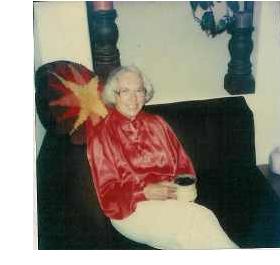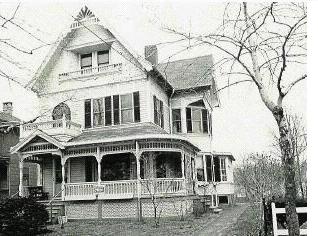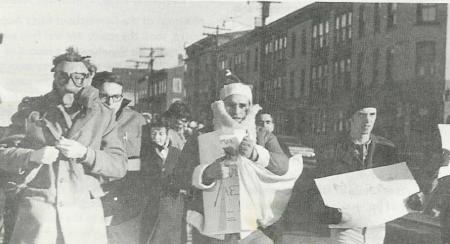Stories
The Black Panthers
in New Haven
The American
Independent Movement
Union-Organizing at Yale
* * *
After our year in Italy, Nina and I returned to New Haven and decided to live in Fair Haven which was one of New Haven's old "ethnic" neighborhoods that had been populated by successive waves of Irish, Italian and now Black and Hispanic working class families. At first we lived in an apartment in the center of Fair Haven at the corner of Grand and Ferry. Then, along with Rick Wolff and Harriet Fraad of AIM, we bought a beautiful, big house on East Pearl Street that had been built in the 19th century by the captain of the oyster-harvesting fleet moored below in the Quinnipiac River which is still there to this day.
 We totally rebuilt the second floor of the house with archways, and my mother made stained glass panels for the half-circle window and crocheted sunburst backs for the homemade couches. The legs of the couches were cast-iron sewer pipes and, as one can see from the photo, the candlesticks were sections of posts. We weatherized the cathedral-ceiling of the top floor and put in a picture window overlooking the river which became my study. And I built a kitchen table-counter with marble and oak sections from the old anatomy labs at yale.
We totally rebuilt the second floor of the house with archways, and my mother made stained glass panels for the half-circle window and crocheted sunburst backs for the homemade couches. The legs of the couches were cast-iron sewer pipes and, as one can see from the photo, the candlesticks were sections of posts. We weatherized the cathedral-ceiling of the top floor and put in a picture window overlooking the river which became my study. And I built a kitchen table-counter with marble and oak sections from the old anatomy labs at yale.
In the early years our big house became something of a "pad" for the New Left, although we never had a commune in the true sense of the term. At one point two young organizers, Renée Poirier and Debbie Anderson, lived on the third floor. They went to Wesleyan and helped organize the women's center there, and went on, respectively, to marry labor organizers Henry Tamarin and an IAM organizer on the West Coast whose name I forget. At one point, the young John Wilhelm lived next door, before he met Betsy Gilbertson and married her, going on in later years to become a labor leader who pioneered the organizing of undocumented workers into the trade unions. Later, Hank Murray of the Auto Workers and Lynne Karsten, who had organized at Yale with Nina, lived in the downstairs apartment after Rick and Harriet moved out.
 In the context of AIM's political goals, we became involved with neighborhood organizing. Along with long-time Fair Haveners, young Frankie Annunziato and Ann Quinn, married to a railroad worker and mother of four beautiful daughters, we established the Fair Haven Betterment Association. One of the daughters, Cathy, became a labor organizer and eventually married another organizer, Bill Meyerson. For a while the Betterment Association ran a neighborhood center and hangout for teenage kids on Poplar Street just off Grand Avenue. Nina became the first director of the Fair Haven Health Clinic when it was still located at the local school.
In the context of AIM's political goals, we became involved with neighborhood organizing. Along with long-time Fair Haveners, young Frankie Annunziato and Ann Quinn, married to a railroad worker and mother of four beautiful daughters, we established the Fair Haven Betterment Association. One of the daughters, Cathy, became a labor organizer and eventually married another organizer, Bill Meyerson. For a while the Betterment Association ran a neighborhood center and hangout for teenage kids on Poplar Street just off Grand Avenue. Nina became the first director of the Fair Haven Health Clinic when it was still located at the local school.
Politicians and developers were carving up New Haven in those years in the so-called redevelopment programs, and neighborhood organizing stood in the way of their profits. At one point the redevelopment director came to the Betterment Association which was all white and told us that a Black neighborhood organization in Fair Haven was preparing violence against us, and at the same time he went to the Black organization and told them that we were planning to attack them. But because our two organizations were on good terms we shared the information and prevented the violence that the authorities were trying to incite.

A well-publicized march of the Fair Haven Betterment Association down Grand Avenue to throw
roses into the foul-smelling Mill River and call for an end to its industrial pollution.
On the left Marty O'Connor and center Frank Annunziato.
Fair Haven had a legacy of Mafia violence although it was beginning to wane in those years. The Mafia Capo was Frankie's uncle who went by the name he had assumed as a professional boxer, Midge Renault. Attending the funeral of Midge Renault in a funeral home on Grand Avenue we were all ostentatiously filmed by the FBI. Later that funeral home became the permanent home of the Fair Haven Health Clinic, and the place that I met Lindsay.
Once when we still lived at Ferry and Grand we were awakened by police in the morning because a Mafia car coming from Chip's Lounge had taken a right turn at our corner which an occupant interpreted as being the way towards the East Rock killing grounds. He jumped out of the car and was gunned down in our back yard. Another time at our neighborhood center on Poplar Street I was invited into a car where the driver, a Mafia hit-man, wanted to show off his special high-power revolver with a silencer. When we heard explosions once in a while at 4 in the morning, we would know that another car got blown up. Once a car was propelled so high that it landed on the roof of the house facing it. At first, the Mafia mostly ran the numbers and counterfeit cigarettes at prices better than those of the state. But then, as shown in the Hollywood movies The Godfather and The French Connection, they started selling the drugs that were brought into the US by government forces to finance the wars in Vietnam and Laos and later Afghanistan and Nicaragua. I went to the cinema with Frankie to see the Godfather and he nodded throughout at the stories he knew from his family, although he pronounced the ending contrived. A few years later I would recount this to a rapt audience of young Soviet filmmakers on the train from Moscow to Leningrad, as they had just seen a private showing of the film.
In later years, even after getting divorced from Nina and moving out to Short Beach, I returned to work in Fair Haven on Pam Saffer's political campaign, "Save Our Neighborhoods" and to sell the Communist Party newspaper in the Quinnipiac Terrace housing project. There was still violence associated with drugs, although I don't think it was any longer controlled by the Mafia. Once there was a 24-hour shootout in the Projects between police and presumed drug dealers. In the family of Virginia and Dalzenia Henry with whom I worked virtually all of the men were in prison.
 |
Stages
1986-1992
Fall of Soviet Empire
1992-1997
UNESCO Culture of Peace Programme